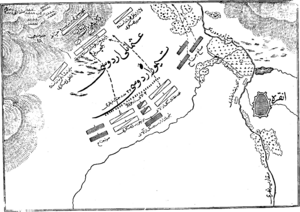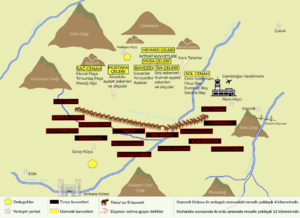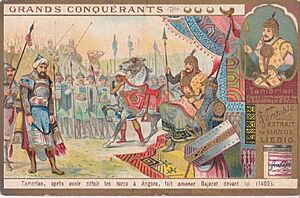Battle of Ankara facts for kids
Quick facts for kids Battle of Ankara |
|||||||
|---|---|---|---|---|---|---|---|
 Battle Of Ankara, Mughal illustration |
|||||||
|
|||||||
| Belligerents | |||||||
| Timurid Empire Aq Qoyunlu Germiyanids |
Ottoman Sultanate Principality of Kastrioti Moravian Serbia District of Branković Anatolian beyliks and Black Tatars |
||||||
| Commanders and leaders | |||||||
| Timur Shah Rukh Khalil Sultan Miran Shah Sultan Husayn Tayichiud Muhammad Sultan Mirza Pir Muhammad Shah-i-Shahan Uthman Beg Yakup II of Germiyan |
Bayezid I (POW) Süleyman Çelebi Mehmed Çelebi İsa Çelebi Musa Çelebi (POW) Mustafa Çelebi (POW) Stefan Lazarević Vuk Lazarević Đurađ Branković Gjon Kastrioti Koja Zaharia Dhimitër Jonima |
||||||
| Strength | |||||||
| 140,000 | 85,000–120,000 | ||||||
The Battle of Ankara (also called Angora) was a huge fight that happened on July 20, 1402. It took place on the Çubuk plain, close to the city of Ankara. This battle was fought between the army of the Ottoman Sultan Bayezid I and the forces of Timur, a powerful ruler from Central Asia. Timur won a major victory, which caused a difficult time for the Ottoman Empire known as the Ottoman Interregnum.
Contents
Why Did the Battle of Ankara Happen?
Timur was a powerful leader from a region called Transoxiana (which is now part of Uzbekistan). He had built a huge empire in Central Asia, becoming one of the strongest rulers since Genghis Khan. Timur wanted to bring back the glory of the old Mongol Empire.
In the late 1300s, Timur's armies conquered parts of Persia and Syria. He also attacked areas in Russia and India. Meanwhile, the Ottoman Empire was growing strong in Anatolia (modern-day Turkey) and Europe.
The main reason for the war was a disagreement between Timur and Sultan Bayezid I. Bayezid demanded money from a local ruler who was loyal to Timur. Timur saw this as a personal insult and a reason to go to war. In 1400, Timur captured the city of Sivas from the Ottomans. He then moved his army towards Anatolia.
In 1402, the Ottomans were busy fighting in Europe. Sultan Bayezid had to stop his attack on Constantinople to face Timur's army. He marched his troops to Ankara to meet Timur.
Who Fought in the Battle?
Historians believe Timur's army was very large, with about 140,000 soldiers. Most of these were cavalry (soldiers on horseback). Timur also had 32 war elephants, which were a fearsome sight on the battlefield.
Sultan Bayezid's Ottoman army was smaller, with about 85,000 to 120,000 soldiers. His army included different groups:
- His own sons led some parts of the army.
- Elite soldiers called Janissaries.
- Muslim fighters from Anatolia.
- Soldiers from European lands that were under Ottoman rule. This included Christian fighters from Serbia and Albania.
- A quarter of the Ottoman troops were recently conquered Tatars.
Some important leaders on the Ottoman side included Stefan Lazarević and Đurađ Branković from Serbia, and Gjon Kastrioti from Albania.
How the Armies Lined Up
Sultan Bayezid's soldiers were tired and thirsty from their long march in the summer heat. His generals advised him to take a defensive position. They suggested that if Timur's forces pushed them back, they should retreat into the mountains. This would force Timur's army to chase them in the hot weather, giving the Ottomans an advantage.
However, Bayezid decided to attack instead. He marched his army eastward. But Timur was clever. He secretly moved his army southwest, rested his troops, and then positioned them behind the Ottoman army. Timur's forces even used the abandoned Ottoman tents and water sources.
In Timur's army, Timur himself led the center. His sons, Miran and Rukh, commanded the right and left sides. His grandsons led the front lines.
For the Ottomans, Sultan Bayezid led the center with his Janissaries. His son Suleyman commanded the left side with the best troops. Stefan Lazarević and his Balkan soldiers held the right side. Another son, Mehmed, was in charge of the rear guard.
The Battle Begins
The battle started with a big attack from the Ottoman army. Timur's horse archers quickly responded with many arrows. Thousands of Ottoman soldiers were killed, and many surrendered to Timur.
The Serbian knights, led by Stefan Lazarević, fought bravely. They wore heavy black armor that protected them well from Timur's arrows. They managed to break through Timur's lines three times. Stefan even told Bayezid to escape with him, but Bayezid refused. The Serbian troops were able to save one of Bayezid's sons and the Ottoman treasury. They then made their way to Constantinople. Timur was very impressed by the Serbian soldiers, saying they "fight like lions."
During the battle, Timur used a clever trick. He redirected the Çubuk creek, which was the main water source for both armies. This left the Ottoman army without water, making them even more tired and thirsty.
The final part of the battle happened at Catal hill. The Ottoman army, exhausted and without water, was defeated. Sultan Bayezid tried to escape to the nearby mountains with a few hundred horsemen. However, Timur's forces surrounded the mountains and captured him. Bayezid died in captivity three months later.
The Ottoman army was already outnumbered, but it became even weaker when many soldiers deserted. The Black Tatars and the Sipahis (Ottoman cavalry) from Anatolia left Bayezid's side and joined Timur's forces.
What Happened After the Battle?
After his victory, Timur moved through western Anatolia. He attacked and captured the city of Smyrna, which was a stronghold of the Christian Knights Hospitalers.
The Battle of Ankara was a disaster for the Ottoman Empire. It almost completely destroyed the empire and led to a long civil war among Bayezid's sons. This civil war lasted for 11 years, until 1413.
This battle is also very important in Ottoman history because it was the only time an Ottoman Sultan was captured alive by an enemy.
See also
- Siege of Ankara




